Introduction to Probability Steven J Miller Williams College

Introduction to Probability Steven J Miller, Williams College sjm 1@Williams. edu https: //web. williams. edu/Mathematics/sjmiller/public_html/math/talks. html 1

Part I: Factorials https: //web. williams. edu/Mathematics/sjmiller/public_html/math/talks. html 2

Basics • Will explore simple probabilities. • Problems from card games, dice, …. • In many situations each event is equally likely, so the probability an event A happens is the number of ways A can happen, divided by the number of ways something can happen. • Example: Imagine we roll a fair die; our result is in the set {1, 2, 3, 4, 5, 6}. • What is the probability we roll a 6? • What is the probability we roll an even number? 3

Basics • Will explore simple probabilities. • Problems from card games, dice, …. • In many situations each event is equally likely, so the probability an event A happens is the number of ways A can happen, divided by the number of ways something can happen. • Example: Imagine we roll a fair die; our result is in the set {1, 2, 3, 4, 5, 6}. • What is the probability we roll a 6? 1/6 (six possible rolls, only one is a 6) • What is the probability we roll an even number? 3/6 or 1/2 (six possible rolls, and 2, 4 and 6 are even while the rest are odd). 4

Factorial Function n! One of the most useful functions in probability is the factorial function. We denote the factorial of an integer n by writing n! (so n followed by an exclamation point). It has a nice meaning: n! is the number of ways to arrange n objects when order matters. Thus if we want to order the elements of {a} there is just one way. If we want to order the elements of {a, b} there are two ways: ab and ba. If we want to order the elements of {a, b, c} there are six ways: abc, acb, bac, bca, cab, cba (why did we list this way? ) 5

Factorial Function n! It has a nice meaning: n! is the number of ways to arrange n objects when order matters. If we want to order the elements of {a, b, c} there are six ways: abc, acb, bac, bca, cab, cba (why did we list this way? ) We want to make sure we do not miss any cases. We first do all the ways with a as the first element, and then use the PREVIOUS result about how to order a set of two elements. Then we do all the ways with b as the first element, then all the ways with c first. 6

Factorial Function n! It has a nice meaning: n! is the number of ways to arrange n objects when order matters. If we want to order the elements of {a, b, c} there are six ways: abc, acb, bac, bca, cab, cba (why did we list this way? ) 7

Factorial Function n! It has a nice meaning: n! is the number of ways to arrange n objects when order matters. How many ways are there to order {a, b, c, d}? 8

Factorial Function n! It has a nice meaning: n! is the number of ways to arrange n objects when order matters. How many ways are there to order {a, b, c, d}? 9

Factorial Function n! The factorial function grows very rapidly. • The number of ways to order a deck of 52 cards is 52!, which is 80658175170943878571660636856403766975289505440883277824000000 (or about 1068). To put in perspective, there about 1080 to 1090 objects in the universe! • The number of ways to order the standard alphabet is 26! which is 403291461126605635584000000 (or about 1026). 10

Factorial Function n! What should 0! equal? 4! = 24 3! = 6 2! = 2 1! = 1 We have the interpretation that n! is the number of ways to order n objects when order matters. How many ways are there to order zero objects? 11

Factorial Function n! What should 0! equal? 4! = 24 3! = 6 2! = 2 1! = 1 We have the interpretation that n! is the number of ways to order n objects when order matters. How many ways are there to order zero objects? We DEFINE 0! to be 1; there is one way to do nothing (you can’t do nothing in more than one way). This turns out to be a VERY useful definition. 12

Factorial Function and Recursion • 13

Part II: Permutations https: //web. williams. edu/Mathematics/sjmiller/public_html/math/talks. html 14

Permutations: n. Pr or n. Pr The factorial function is great for ordering n objects; what if we only want to order some of them? For example, imagine we have five people: {a, b, c, d, e}. How many ways are there to choose two people where order matters (so the first chosen is president, the second is vice-president)? How many ways are there to choose three people where order matters? 15

Permutations: n. Pr The factorial function is great for ordering n objects; what if we only want to order some of them? n. Pr or n. Pr is the number of ways to choose r people from n when order matters. P stands for permutations. For example, imagine we have five people: {a, b, c, d, e}. How many ways are there to choose two people where order matters (so the first chosen is president, the second is vice-president)? • 20 ways: We have 5 choices for the first spot, and then 4 for the second: 5 * 4 = 20. How many ways are there to choose three people where order matters? • 60 ways: We have 5 choices for the first spot, 4 for the second, then 3 for the third: 5 * 4 * 3 = 60. We denote the first 5 P 2 or 5 P 2 and the second 5 P 3 or 5 P 3. 16

Permutations: n. Pr • 17

Permutations: n. Pr • 18

Permutations: n. Pr • 19

Permutations: n. Pr • 20

Permutations: n. Pr • 21

Permutations: n. Pr • 22

Permutations: n. Pr • 23

Permutations: n. Pr • 24

Part III: Combinations https: //web. williams. edu/Mathematics/sjmiller/public_html/math/talks. html 25

Permutation Review: n. Pr or n. Pr We saw n! is the number of ways of order n objects when order matters. Then n. Pr or n. Pr is the number of ways of choosing r objects from n, when order matters. Note n! is n. Pr for some r – what r is it? 26

Permutation Review: n. Pr or n. Pr • 27

Combinations: n. Cr or n. Cr We saw n! is the number of ways of order n objects when order matters. Then n. Pr or n. Pr is the number of ways of choosing r objects from n, when order matters. Note n! is n. Pr for some r – it is r = n. We now introduce a new function: n. Cr or n. Cr is the number of ways to choose r objects from n when order DOES NOT matter; the C stands for combinations. Let’s evaluate n. Cr for some r; can you think of some r where it is easy to figure out what n. Cr is? Try r = …. 28

Combinations: n. Cr or n. Cr We saw n! is the number of ways to order n objects when order matters. Then n. Pr or n. Pr is the number of ways of choosing r objects from n, when order matters. Note n! is n. Pr for some r – it is r = n. We now introduce a new function: n. Cr or n. Cr is the number of ways to choose r objects from n when order DOES NOT matter; the C stands for combinations. Let’s evaluate n. Cr for some r; can you think of some r where it is easy to figure out what n. Cr is? Hint: Try r = 0 or n. Then we find…. 29

Combinations: n. Cr or n. Cr We saw n! is the number of ways to order n objects when order matters. Then n. Pr or n. Pr is the number of ways of choosing r objects from n, when order matters. Note n! is n. Pr for some r – it is r = n. We now introduce a new function: n. Cr or n. Cr is the number of ways to choose r objects from n when order DOES NOT matter; the C stands for combinations. Let’s evaluate n. Cr for some r; can you think of some r where it is easy to figure out what n. Cr is? Hint: Try r = 0 or n. Then we find n. C 0 = n. Cn = 1. 30

Combinations: n. Cr or n. Cr We now introduce a new function: n. Cr or n. Cr is the number of ways to choose r objects from n when order DOES NOT matter; the C stands for combinations. Let’s evaluate n. Cr for some r; can you think of some r where it is easy to figure out what n. Cr is? We find n. C 0 = n. Cn = 1. What would n. Cr be when r = 1 or n-1? Note this is different than most presentations; we have NOT given the formula for n. Cr but instead are trying to find it…. 31

Combinations: n. Cr or n. Cr We now introduce a new function: n. Cr or n. Cr is the number of ways to choose r objects from n when order DOES NOT matter; the C stands for combinations. Let’s evaluate n. Cr for some r. We find n. C 0 = n. Cn = 1. What would n. Cr be when r = 1 or n-1? • If r = 1 we choose just one person. There are n ways to choose one person so n. C 1 = n. • If r = n-1 we choose everyone but one person for our set. There are n ways to choose a person to exclude, so n. Cn-1 = n. Hmm. Notice n. C 0 = n. Cn = 1 and n. C 1 = n. Cn-1 = n. Any thoughts on what might be true more generally? Maybe compare the values at r and at what? 32

Combinations: n. Cr or n. Cr We now introduce a new function: n. Cr or n. Cr is the number of ways to choose r objects from n when order DOES NOT matter; the C stands for combinations. Let’s evaluate n. Cr for some r. We find n. C 0 = n. Cn = 1. What would n. Cr be when r = 1 or n-1? • If r = 1 we choose just one person. There are n ways to choose one person so n. C 1 = n. • If r = n-1 we choose everyone but one person for our set. There are n ways to choose a person to exclude, so n. Cn-1 = n. Hmm. Notice n. C 0 = n. Cn = 1 and n. C 1 = n. Cn-1 = n. Any thoughts on what might be true more generally? Maybe compare the values at r and n-r. Are these equal? 33

Combinations: n. Cr or n. Cr We now introduce a new function: n. Cr or n. Cr is the number of ways to choose r objects from n when order DOES NOT matter; the C stands for combinations. Let’s evaluate n. Cr for some r. We find n. C 0 = n. Cn = 1 and n. C 1 = n. Cn-1 = n. Compare the values at r and n-r. Are these equal? Note choosing r from n to BE in the group is the same as choosing n-r to EXCLUDE. 34

Combinations: n. Cr or n. Cr • 35

Combinations: n. Cr or n. Cr 36

Comparing n. Cr and n. Pr n. Cr or n. Cr is the number of ways to choose r objects from n when order DOES NOT matter, while n. Pr or n. Pr is the number of ways to choose r people from n when order matters. P stands for permutations. • How many ways are there to choose 13 cards from a deck of 52 cards when order matters? • How many ways are there to choose 13 cards from a deck of 52 cards when order does not matter? • What is the probability of getting a given set of 13 cards? 37

Comparing n. Cr and n. Pr n. Cr or n. Cr is the number of ways to choose r objects from n when order DOES NOT matter, while n. Pr or n. Pr is the number of ways to choose r people from n when order matters. P stands for permutations. • How many ways are there to choose 13 cards from a deck of 52 cards when order matters? 52 P 13 = 3, 954, 242, 643, 911, 239, 680, 000 (about 10 21. 6). • How many ways are there to choose 13 cards from a deck of 52 cards when order does not matter? 52 C 13 = 635, 013, 559, 600 (about 1011. 8) • What is the probability of getting a given set of 13 cards? 1/52 C 13 or about 1/1011. 8. 38

Distinct Deals in Bridge n. Cr or n. Cr is the number of ways to choose r objects from n when order DOES NOT matter, while n. Pr or n. Pr is the number of ways to choose r people from n when order matters. P stands for permutations. In a hand of bridge, each of the four players is dealt 13 cards. It does not matter what order you get the cards, only which cards you get. • How many ways are there to deal the cards? 39

Distinct Deals in Bridge • 40

Distinct Deals in Bridge • 41

Part IV: May the Fourth Probabilities https: //web. williams. edu/Mathematics/sjmiller/public_html/math/talks. html 42

Happy Star Wars Day! • 43

The Geometric Series Formula (Review) • 44

The Geometric Series Converges if |r| < 1: Review • 45

The Geometric Series Converges if |r| < 1: Review • 46

The Geometric Series Converges if |r| < 1: Review • 47

The Geometric Series Converges if |r| < 1: Review • 48

The Geometric Series Formula: Review • 49

The Geometric Series Formula: Review • 50

The Geometric Series Formula: Review • 51

The Geometric Series Formula: Review • 52

The Darth Vader Problem Only the Emperor is less forgiving than Darth Vader; one mistake and you are dead! No one seems to fail him twice…. If your probability of failing him on a task is p, how many tasks till you die? 53

The Darth Vader Problem If your probability of failing him on a task is p, how many tasks till you die? Could be unlucky and fail at the first task and die. Could be very lucky and never fail and live a long, long time…. • What is the probability your first failure is on your first task? • What is the probability your first failure is on your second task? • What is the probability your first failure is on your third task? • What is the probability your first failure is on your nth task? 54

The Darth Vader Problem If your probability of failing him on a task is p, how many tasks till you die? Could be unlucky and fail at the first task and die. Could be very lucky and never fail and live a long, long time…. • What is the probability your first failure is on your first task? p • What is the probability your first failure is on your second task? (1 -p) p • What is the probability your first failure is on your third task? (1 -p)2 p • What is the probability your first failure is on your nth task? (1 -p)n-1 p 55

The Darth Vader Problem • 56

The Darth Vader Problem • 57

The Darth Vader Problem: LOWER BOUND • 58

The Darth Vader Problem: LOWER BOUND • 59

The Darth Vader Problem: UPPER BOUND • 60

The Darth Vader Problem: UPPER BOUND • 61

The Darth Vader Problem • 62

The Darth Vader Problem • 63

The Darth Vader Problem • 64

The Darth Vader Problem • 65

The Darth Vader Problem • 66

The Darth Vader Problem 67

Part V: Die Another Game https: //youtu. be/t. Bz 2 GIxf. YXA? t=2 https: //web. williams. edu/Mathematics/sjmiller/public_html/math/talks. html 68

The Darth Vader Problem: Review Probability of failing a task is p, how many tasks till you die? Answer: Expect 1/p. Equivalently, if the probability of a success is p, the number of tasks or tries you need before the first success is 1/p. 69

The Sixes Game Probability of failing a task is p, how many tasks till you die? Answer: Expect 1/p. Equivalently, if the probability of a success is p, the number of tasks or tries you need before the first success is 1/p. We can use this to study a new game! The sixes game: you roll a fair die until you get a 6. How many rolls do you expect before this happens? 70

The Sixes Game Probability of failing a task is p, how many tasks till you die? Answer: Expect 1/p Equivalently, if the probability of a success is p, the number of tasks or tries you need before the first success is 1/p. We can use this to study a new game! The sixes game: you roll a fair die until you get a 6. How many rolls do you expect before this happens? Answer: As the probability of rolling a 6 is p = 1/6 (all six outcomes are equally likely) we expect it will take 6 rolls. 71

The Double Sixes Game You have two fair die. On each turn you can roll one or both of the die. The goal is to have both show a 6. Thus once one of the die lands on a 6 you can stop rolling it. Questions: • How many rolls do you expect before you have double sixes? • What is the probability you win on your first turn? On your second? On your n th? Can we use the Darth Vader Theorem here? Why or why not? 72

The Double Sixes Game You have two fair die. On each turn you can roll one or both of the die. The goal is to have both show a 6. Thus once one of the die lands on a 6 you can stop rolling it. Questions: • How many rolls do you expect before you have double sixes? • What is the probability you win on your first turn? On your second? On your n th? Can we use the Darth Vader Theorem here? Why or why not? Hard to use: the difficulty is that our probability of a success is NOT constant; it depends on whether or not we rolled a 6 earlier…. Need a new method. 73

The Double Sixes Game You have two fair die. On each turn you can roll one or both of the die. The goal is to have both show a 6. Thus once one of the die lands on a 6 you can stop rolling it. We will first find the probability of winning after a given number of rolls. It is easy to find the probability of winning on the first roll: It is ? ? ? . 74

The Double Sixes Game You have two fair die. On each turn you can roll one or both of the die. The goal is to have both show a 6. Thus once one of the die lands on a 6 you can stop rolling it. We will first find the probability of winning after a given number of rolls. It is easy to find the probability of winning on the first roll: It is 1/36. What is the probability you win on the second roll? It is ? ? ? . 75

The Double Sixes Game You have two fair die. On each turn you can roll one or both of the die. The goal is to have both show a 6. Thus once one of the die lands on a 6 you can stop rolling it. We will first find the probability of winning after a given number of rolls. It is easy to find the probability of winning on the first roll: It is 1/36. What is the probability you win on the second roll? It is 10/36 * 1/6 + 25/36 * 1/36. But why? ? ? 76

The Double Sixes Game You have two fair die. On each turn you can roll one or both of the die. The goal is to have both show a 6. Thus once one of the die lands on a 6 you can stop rolling it. 77

Great Probability Results We can continue the analysis, but there are more and more branches as we go down. We introduce a WONDERFUL idea in probability: The Law of Complementary Events: If the probability something happens is p, then the probability it does not happen is ? ? . 78

Great Probability Results We can continue the analysis, but there are more and more branches as we go down. We introduce a WONDERFUL idea in probability: The Law of Complementary Events: If the probability something happens is p, then the probability it does not happen is 1 -p. 79

Great Probability Results We introduce another WONDERFUL idea in probability: The Law of Double Counting: The probability A or B happens is the sum of the probability each happens minus the probability they both happen: Prob(A or B) = Prob(A) + Prob(B) – Prob(A and B). 80

The Double Sixes Game You have two fair die. On each turn you can roll one or both of the die. Want both to show a 6. Once one of the die lands on a 6 you can stop rolling it. The Law of Complementary Events: If the probability something happens is p, then the probability it does not happen is 1 -p. The Law of Double Counting: The probability A or B happens is the sum of the probability each happens minus the probability they both happen: Prob(A or B) = Prob(A) + Prob(B) – Prob(A and B). What is the probability we win by the nth turn? It is 1 minus the probability we have NOT won. What is the probability we haven’t won? It is ? ? ? . 81

The Double Sixes Game You have two fair die. On each turn you can roll one or both of the die. Want both to show a 6. Once one of the die lands on a 6 you can stop rolling it. The Law of Complementary Events: If the probability something happens is p, then the probability it does not happen is 1 -p. The Law of Double Counting: The probability A or B happens is the sum of the probability each happens minus the probability they both happen: Prob(A or B) = Prob(A) + Prob(B) – Prob(A and B). What is the probability we win by the nth turn? It is 1 minus the probability we have NOT won. What is the probability we haven’t won? It is (5/6)n + (5/6)n – (25/36)n. Where did this come from? It is the probability the first die is never a 6 PLUS the probability the second is never a six, MINUS the probability neither die is ever a 6 (we must subtract as we we DOUBLE COUNTED that probability). 82

The Double Sixes Game You have two fair die. On each turn you can roll one or both of the die. The goal is to have both show a 6. Thus once one of the die lands on a 6 you can stop rolling it. The Law of Complementary Events: If the probability something happens is p, then the probability it does not happen is 1 -p. What is the probability we win BY the nth turn? 1 – 2*(5/6)n + (25/36)n. It is 1 minus the probability we have NOT won. What is the probability we haven’t won? It is (5/6)n + (5/6)n – (25/36)n. So…, what is the probability we win ON the nth turn? 83

The Double Sixes Game You have two fair die. On each turn you can roll one or both of the die. The goal is to have both show a 6. Thus once one of the die lands on a 6 you can stop rolling it. The Law of Complementary Events: If the probability something happens is p, then the probability it does not happen is 1 -p. What is the probability we win BY the nth turn? 1 – 2*(5/6)n + (25/36)n. It is 1 minus the probability we have NOT won. What is the probability we haven’t won? It is (5/6)n + (5/6)n – (25/36)n. So…, what is the probability we win ON the nth turn? It is the probability we win BY the nth turn MINUS the probability we win BY the (n-1)st turn! (1 – 2*(5/6)n + (25/36)n) – (1 – 2*(5/6)n-1 + (25/36)n-1)84

The Double Sixes Game You have two fair die. On each turn you can roll one or both of the die. The goal is to have both show a 6. Thus once one of the die lands on a 6 you can stop rolling it. The Law of Complementary Events: If the probability something happens is p, then the probability it does not happen is 1 -p. What is the probability we win BY the nth turn? 1 – 2*(5/6)n + (25/36)n. It is 1 minus the probability we have NOT won. What is the probability we haven’t won? It is (5/6)n + (5/6)n – (25/36)n. So…, what is the probability we win ON the nth turn? It is the probability we win BY the nth turn MINUS the probability we win BY 85 the (n-1)st turn! (2/6)(5/6)n-1 – (11/36)(25/36)n-1.

The Double Sixes Game You have two fair die. On each turn you can roll one or both of the die. The goal is to have both show a 6. Thus once one of the die lands on a 6 you can stop rolling it. Probability win on nth turn: (2/6)(5/6)n-1 – (11/36)(25/36)n-1. 100 trials 10, 000 trials 100, 000 trials 86

The Double Sixes Game: Code Mathematica code to simulate 87

The Double Sixes Game: Expected Value Need the FULL strength of the Darth Vader Theorem (friendly version). 88

The Double Sixes Game: Expected Value • 89

The Double Sixes Game: Expected Value • 90

The Double Sixes Game: Expected Value • 91

The Double Sixes Game: Expected Value • 92

The Double Sixes Game: Expected Value • 93

The Double Sixes Game: Expected Value • 94

The Double Sixes Game: Expected Value • 95

The Double Sixes Game: Expected Value • 96

Review: Big Takeaways The Law of Complementary Events: If the probability something happens is p, then the probability it does not happen is 1 -p. The Law of Double Counting: The probability A or B happens is the sum of the probability each happens minus the probability they both happen: Prob(A or B) = Prob(A) + Prob(B) – Prob(A and B). The Power of Algebra: Sometimes have to do a bit of algebraic manipulations to make what you have look like something you know. 97

Part VI: Bridge Hands: Long Suits https: //web. williams. edu/Mathematics/sjmiller/public_html/math/talks. html 98

Review: n. Cr • 99

Review: Distinct Deals in Bridge • 100

Long Suits in Bridge In a hand of bridge, each of the four players is dealt 13 cards. It does not matter what order you get the cards, only which cards you get. What is the probability you are dealt at least 7 cards in a suit? 101

Long Suits in Bridge In a hand of bridge, each of the four players is dealt 13 cards. It does not matter what order you get the cards, only which cards you get. What is the probability you are dealt at least 7 cards in a suit? Break a hard problem into a lot of easier problems. Note cannot have two 7 card suits (this is why we start with 7 and not 6!). It is Prob(exactly one 7 card suit) + … + Prob(exactly one 13 card suit). What are these probabilities? What is Prob(exactly one 7 card suit)? 102

Long Suits in Bridge • 103

Long Suits in Bridge • 104

Long Suits in Bridge • 105

Long Suits in Bridge • 106

Long Suits in Bridge • 107

Recall a Great Probability Result We recall a WONDERFUL idea in probability: The Law of Double Counting: The probability A or B happens is the sum of the probability each happens minus the probability they both happen: Prob(A or B) = Prob(A) + Prob(B) – Prob(A and B). 108
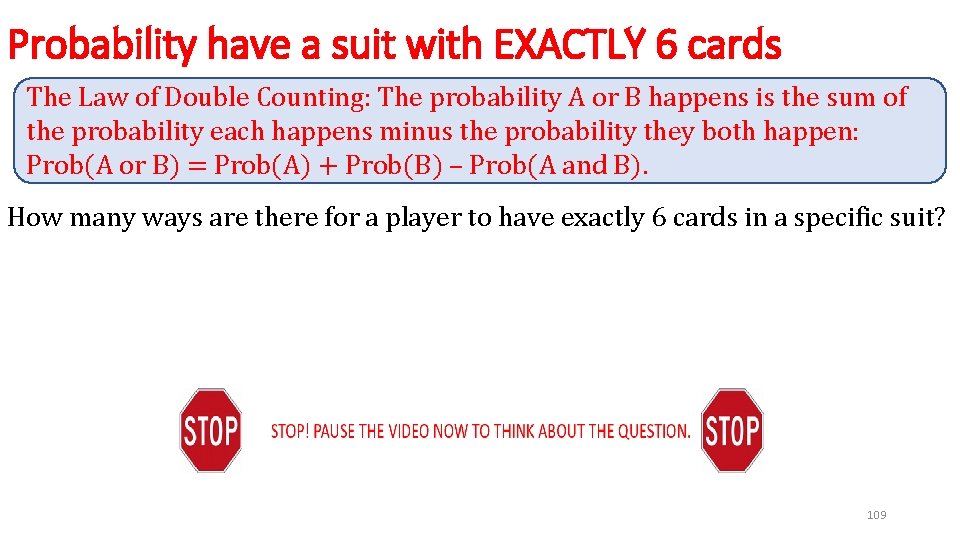
Probability have a suit with EXACTLY 6 cards The Law of Double Counting: The probability A or B happens is the sum of the probability each happens minus the probability they both happen: Prob(A or B) = Prob(A) + Prob(B) – Prob(A and B). How many ways are there for a player to have exactly 6 cards in a specific suit? 109
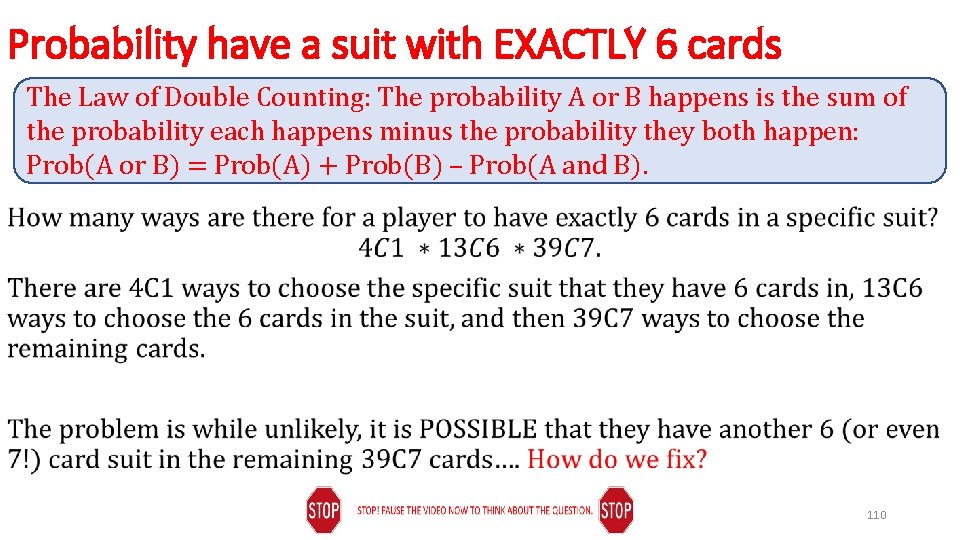
Probability have a suit with EXACTLY 6 cards • The Law of Double Counting: The probability A or B happens is the sum of the probability each happens minus the probability they both happen: Prob(A or B) = Prob(A) + Prob(B) – Prob(A and B). 110

Probability have a suit with EXACTLY 6 cards • The Law of Double Counting: The probability A or B happens is the sum of the probability each happens minus the probability they both happen: Prob(A or B) = Prob(A) + Prob(B) – Prob(A and B). 111
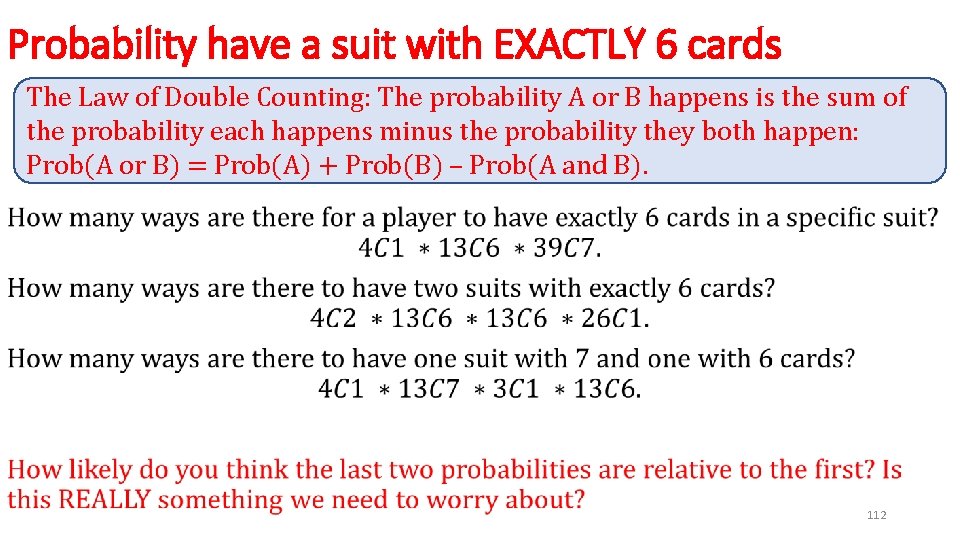
Probability have a suit with EXACTLY 6 cards • The Law of Double Counting: The probability A or B happens is the sum of the probability each happens minus the probability they both happen: Prob(A or B) = Prob(A) + Prob(B) – Prob(A and B). 112
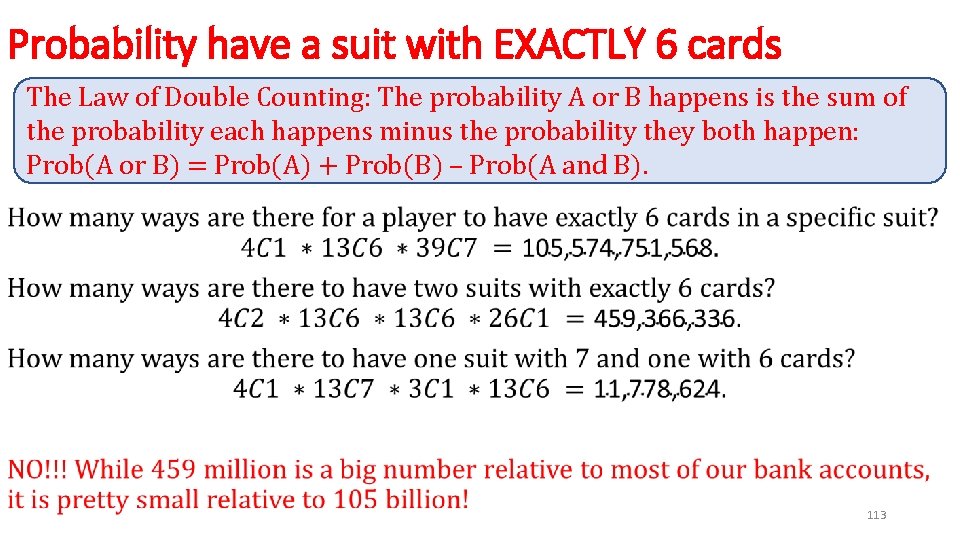
Probability have a suit with EXACTLY 6 cards • The Law of Double Counting: The probability A or B happens is the sum of the probability each happens minus the probability they both happen: Prob(A or B) = Prob(A) + Prob(B) – Prob(A and B). 113
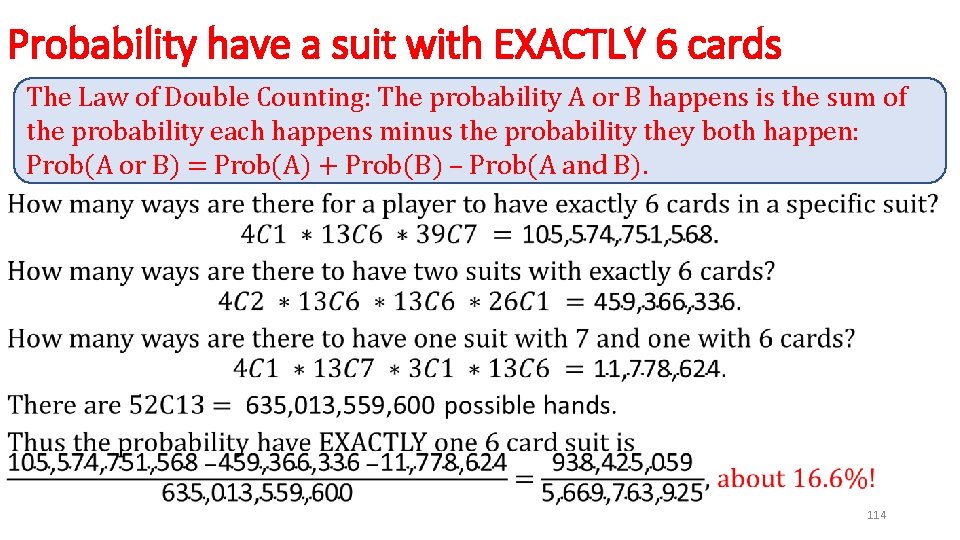
Probability have a suit with EXACTLY 6 cards • The Law of Double Counting: The probability A or B happens is the sum of the probability each happens minus the probability they both happen: Prob(A or B) = Prob(A) + Prob(B) – Prob(A and B). 114
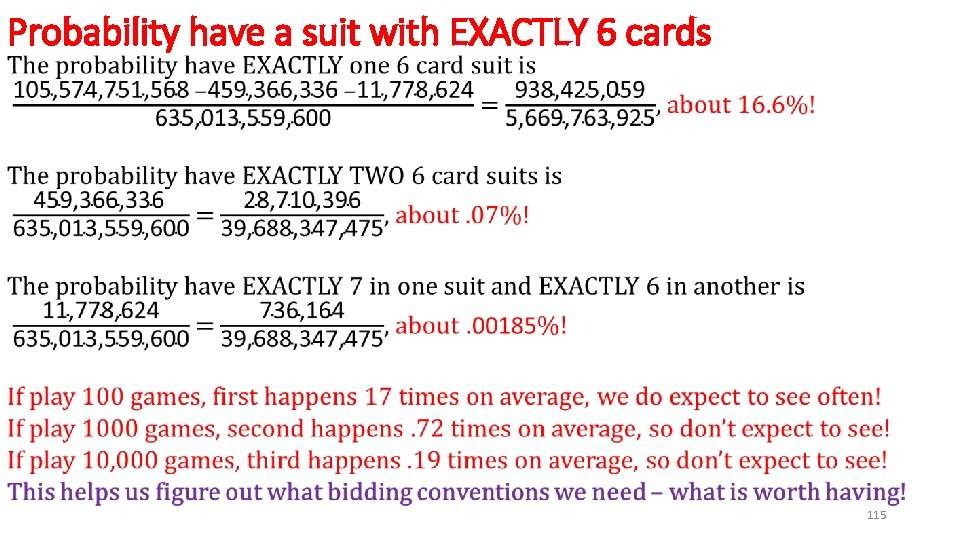
Probability have a suit with EXACTLY 6 cards • 115

Recap • Often more than one way to compute an answer. • Break a complicated probability into a sum of simpler probabilities; important that the cases are disjoint and cover all the possibilities. • Tremendous power in using n. Cr to compute the number of combinations. • Frequently there are smaller effects / lower order terms that you TECHNICALLY need to have the right answer, but they change things by a negligible amount…. • If you can compute something two ways, do so – a great way to check your work! • If you can write a computer program to test your work that is OUTSTANDING! 116
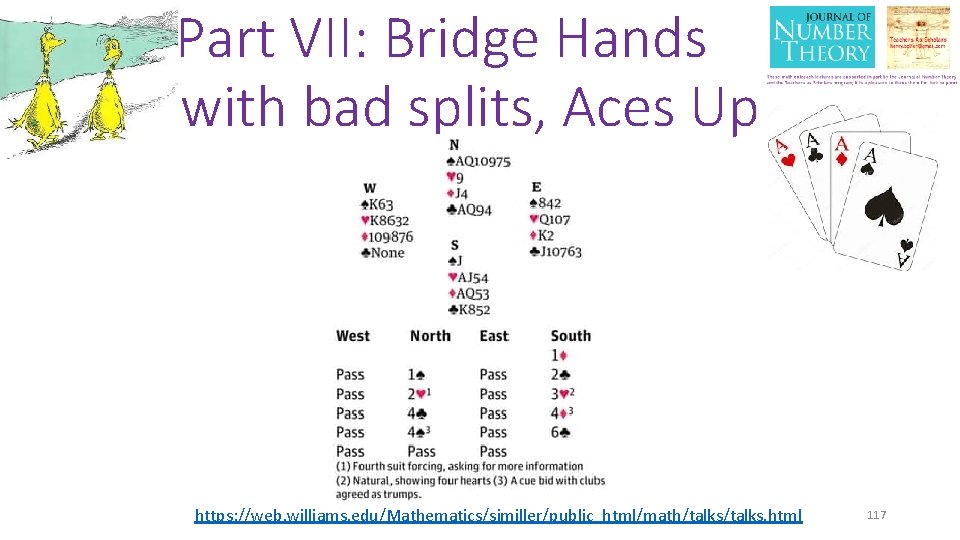
Part VII: Bridge Hands with bad splits, Aces Up https: //web. williams. edu/Mathematics/sjmiller/public_html/math/talks. html 117
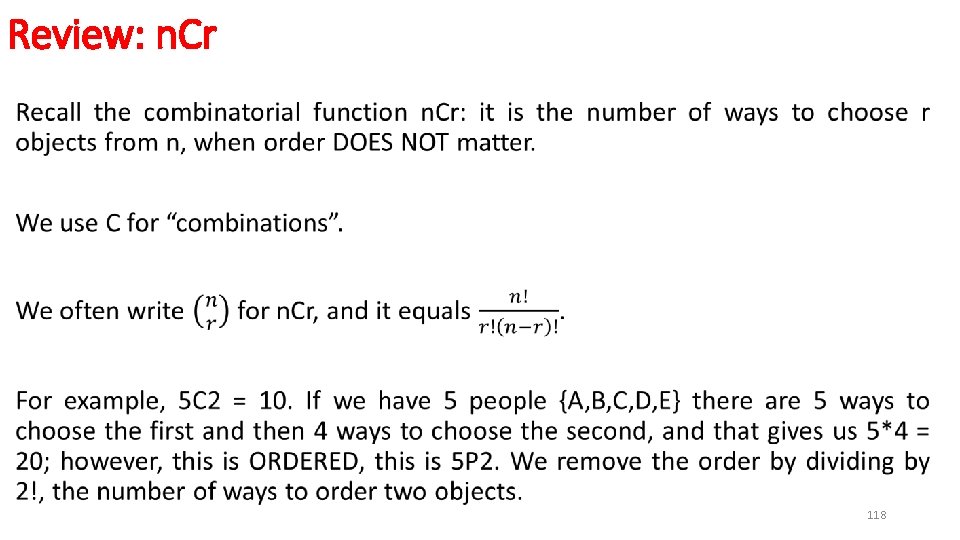
Review: n. Cr • 118
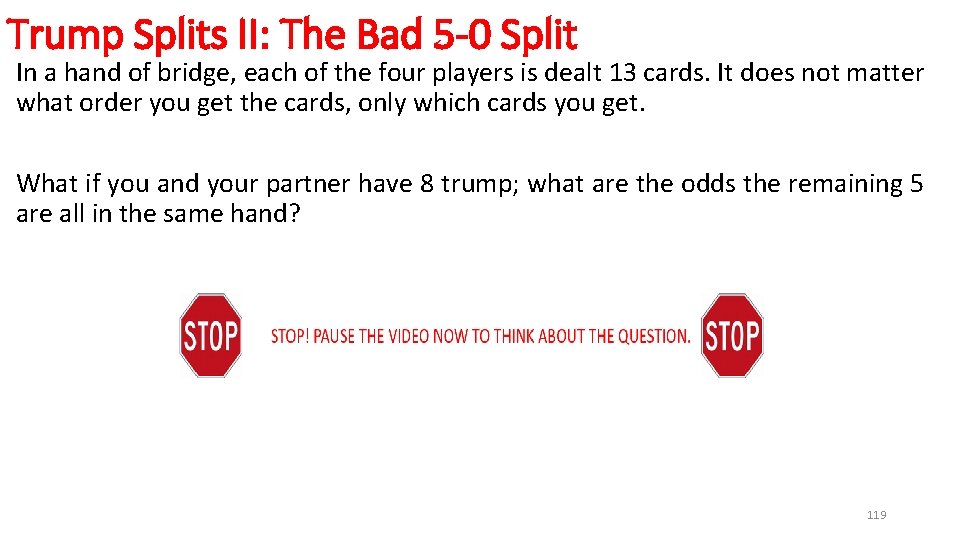
Trump Splits II: The Bad 5 -0 Split In a hand of bridge, each of the four players is dealt 13 cards. It does not matter what order you get the cards, only which cards you get. What if you and your partner have 8 trump; what are the odds the remaining 5 are all in the same hand? 119
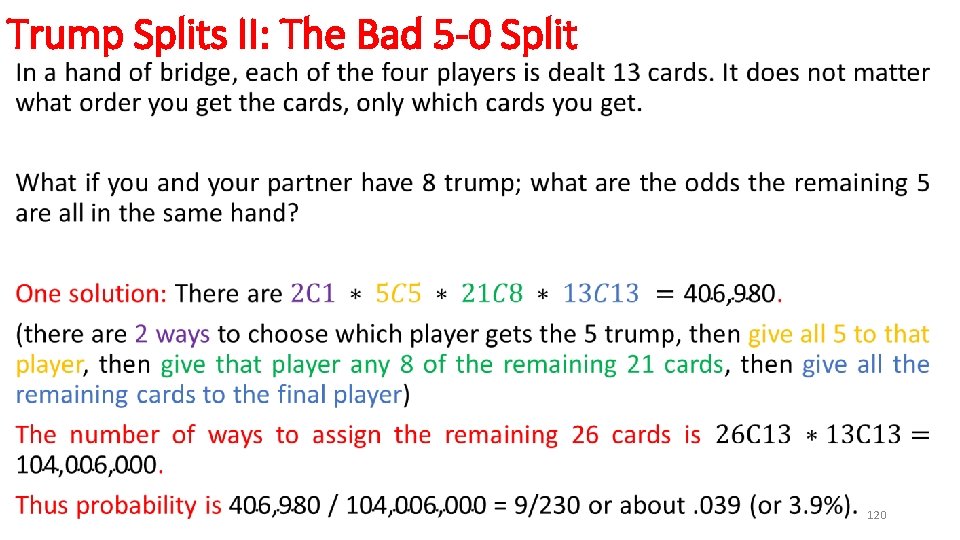
Trump Splits II: The Bad 5 -0 Split • 120

Trump Splits II: The Bad 5 -0 Split 121
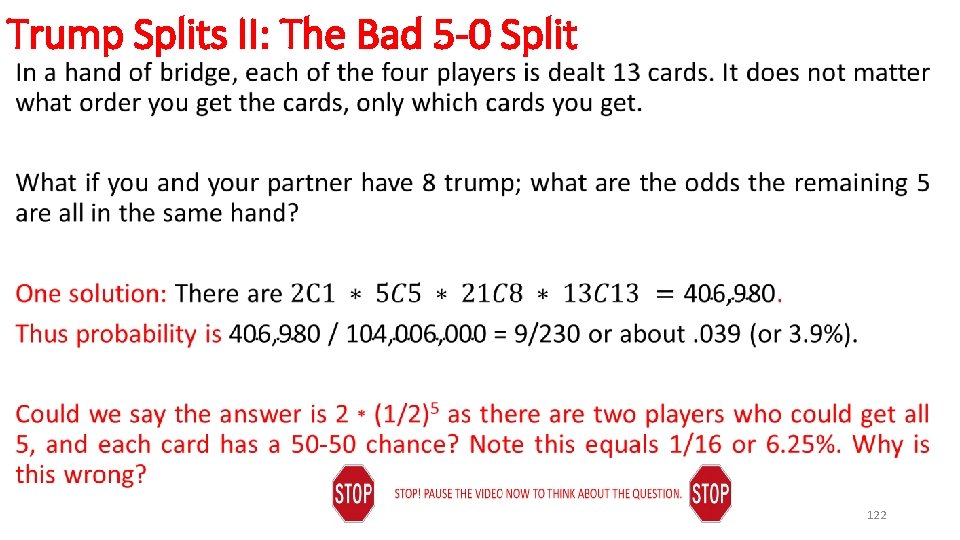
Trump Splits II: The Bad 5 -0 Split • 122
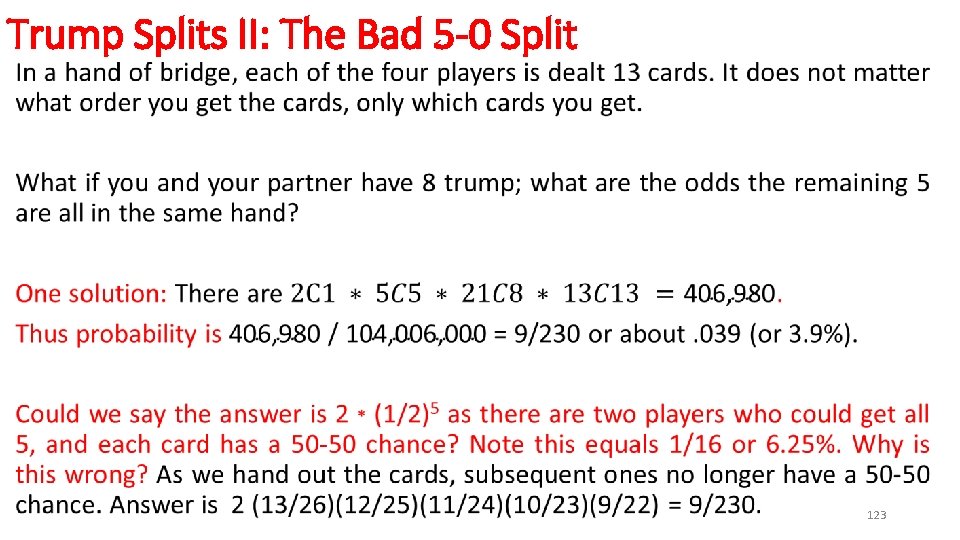
Trump Splits II: The Bad 5 -0 Split • 123
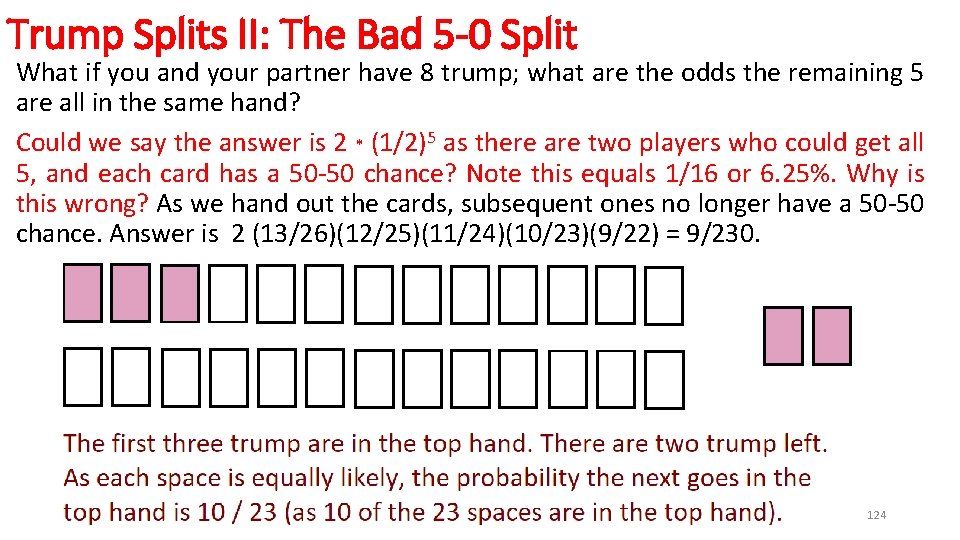
Trump Splits II: The Bad 5 -0 Split What if you and your partner have 8 trump; what are the odds the remaining 5 are all in the same hand? Could we say the answer is 2 * (1/2)5 as there are two players who could get all 5, and each card has a 50 -50 chance? Note this equals 1/16 or 6. 25%. Why is this wrong? As we hand out the cards, subsequent ones no longer have a 50 -50 chance. Answer is 2 (13/26)(12/25)(11/24)(10/23)(9/22) = 9/230. 124

Aces Up What is the probability the last four cards are in different suits, and thus no matter how well you play, you will LOSE? 125

Aces Up What is the probability the last four cards are in different suits? There are many ways to compute this. • We could look at each card, one at a time, and each is in a different suit than the previous. • We can choose one card from each suit. Which do you prefer? Why? Will they give the same answer (they better!). Try to solve it. Note there are 52 P 4 = 6, 497, 400 ways to choose 4 cards when order DOES matters, and 52 C 4 = 270, 725 ways to choose 4 cards when order DOES NOT matter. 126
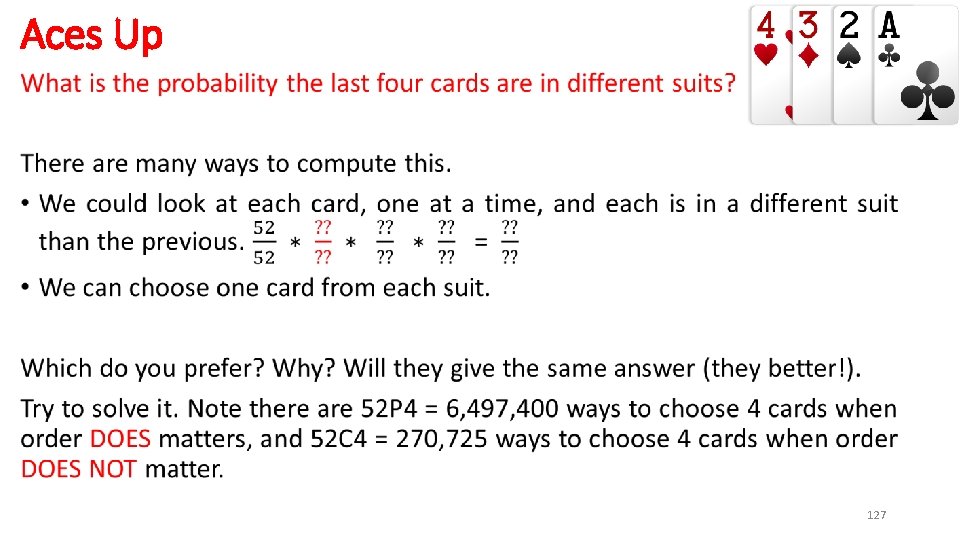
Aces Up • 127

Aces Up • 128
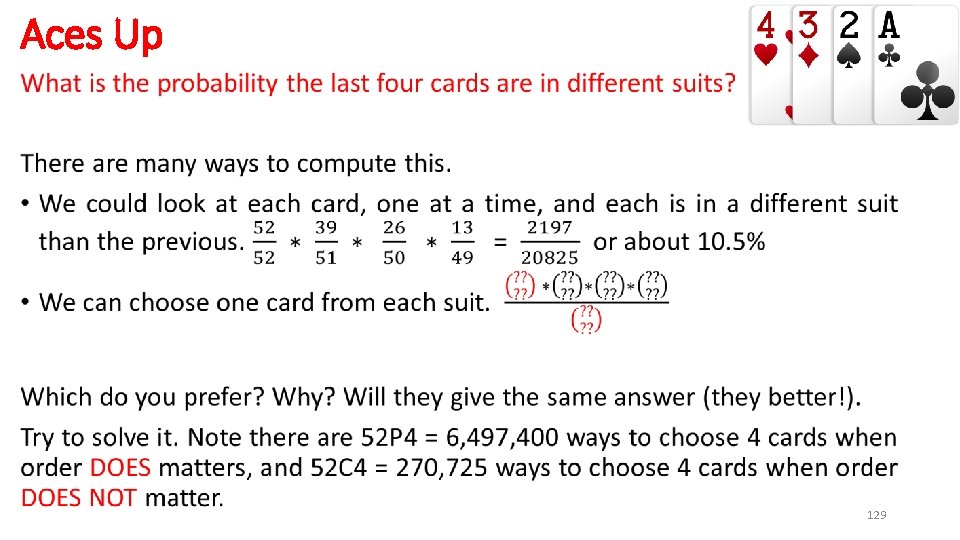
Aces Up • 129
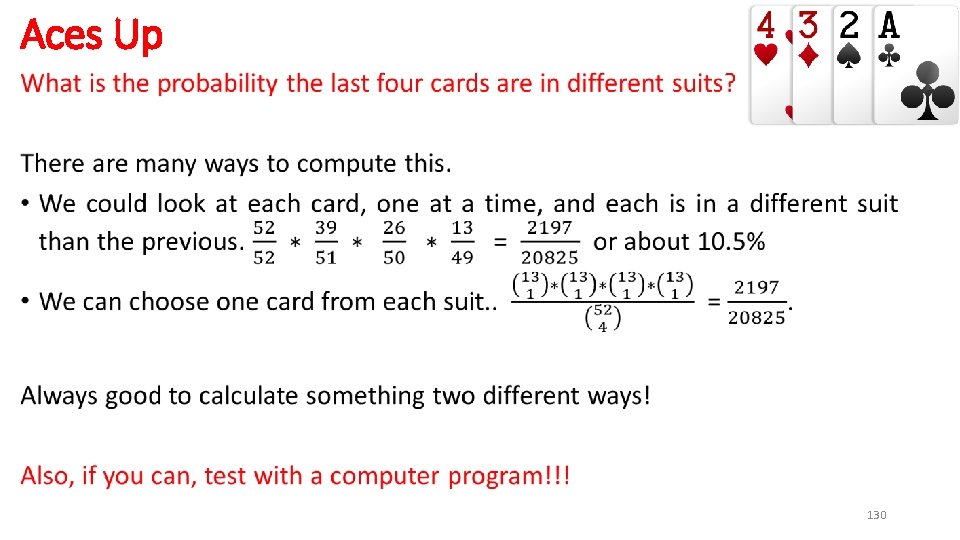
Aces Up • 130

Aces Up What is the probability the last four cards are in different suits? 131
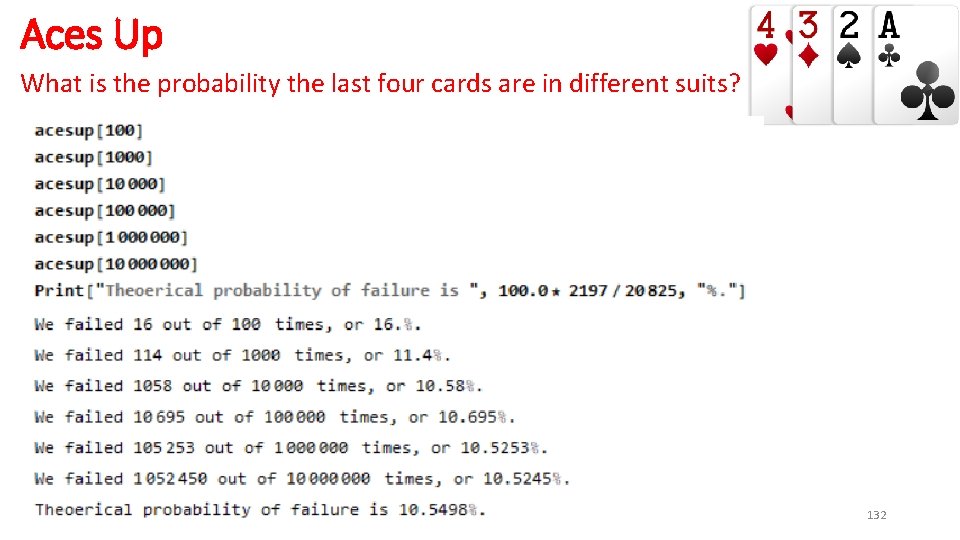
Aces Up What is the probability the last four cards are in different suits? 132

Recap • Often more than one way to compute an answer. • Break a complicated probability into a sum of simpler probabilities; important that the cases are disjoint and cover all the possibilities. • Tremendous power in using n. Cr to compute the number of combinations. • Frequently there are smaller effects / lower order terms that you TECHNICALLY need to have the right answer, but they change things by a negligible amount…. • If you can compute something two ways, do so – a great way to check your work! • If you can write a computer program to test your work that is OUTSTANDING! 133
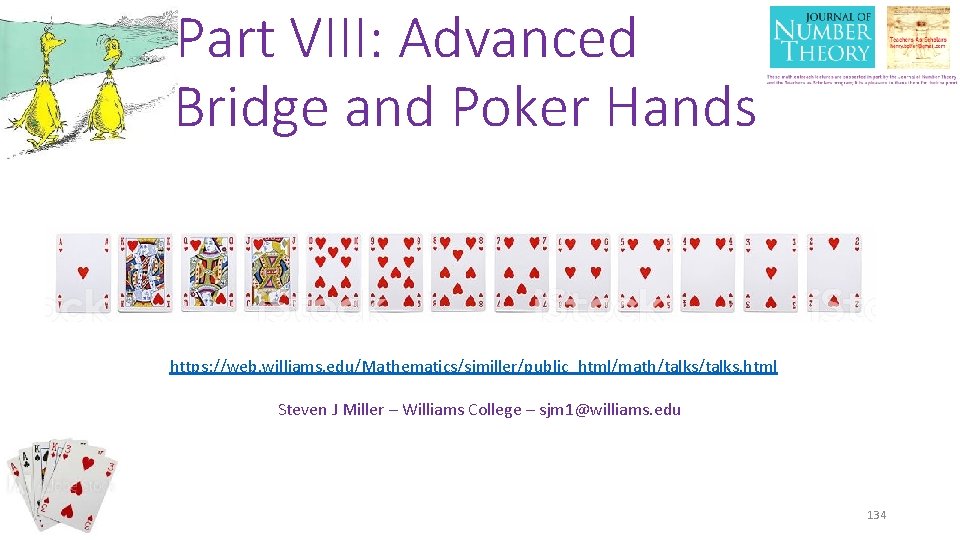
Part VIII: Advanced Bridge and Poker Hands https: //web. williams. edu/Mathematics/sjmiller/public_html/math/talks. html Steven J Miller – Williams College – sjm 1@williams. edu 134
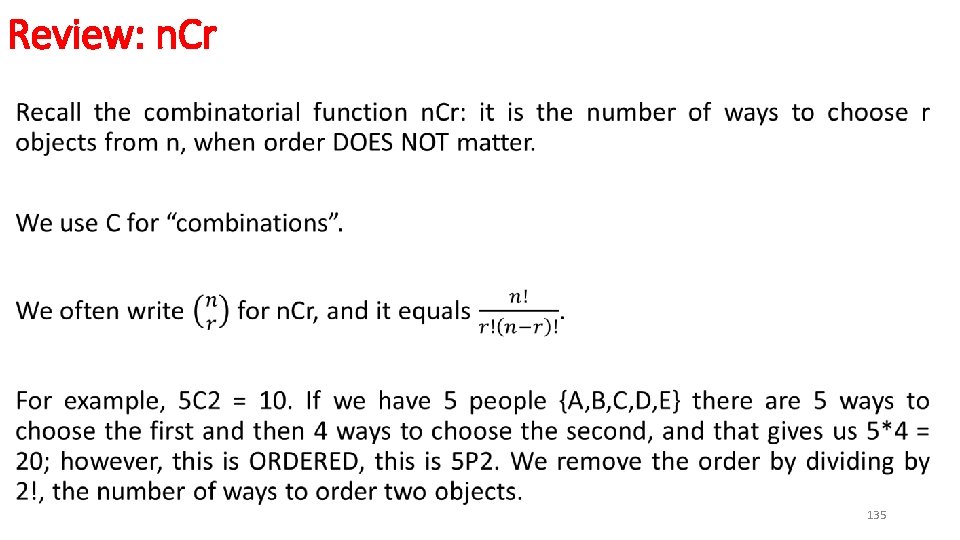
Review: n. Cr • 135
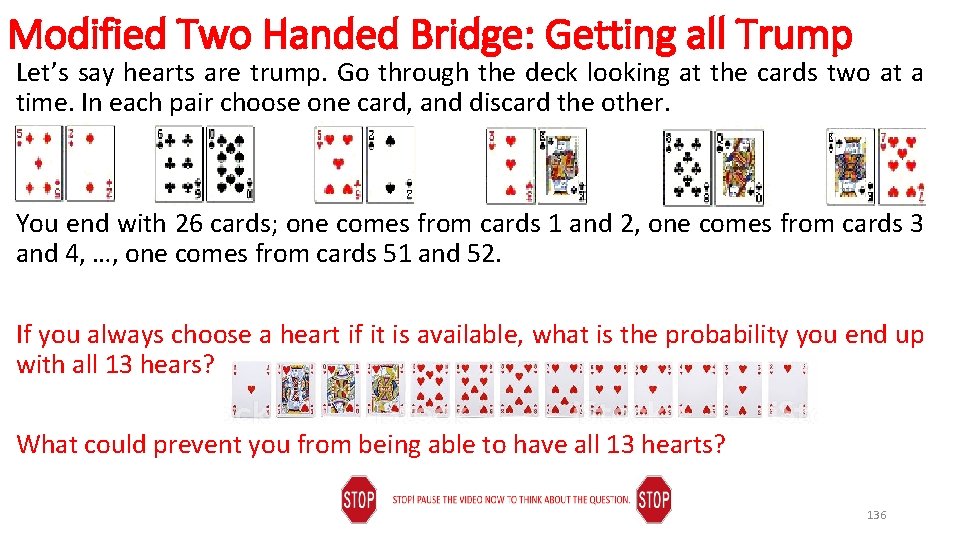
Modified Two Handed Bridge: Getting all Trump Let’s say hearts are trump. Go through the deck looking at the cards two at a time. In each pair choose one card, and discard the other. You end with 26 cards; one comes from cards 1 and 2, one comes from cards 3 and 4, …, one comes from cards 51 and 52. If you always choose a heart if it is available, what is the probability you end up with all 13 hears? What could prevent you from being able to have all 13 hearts? 136
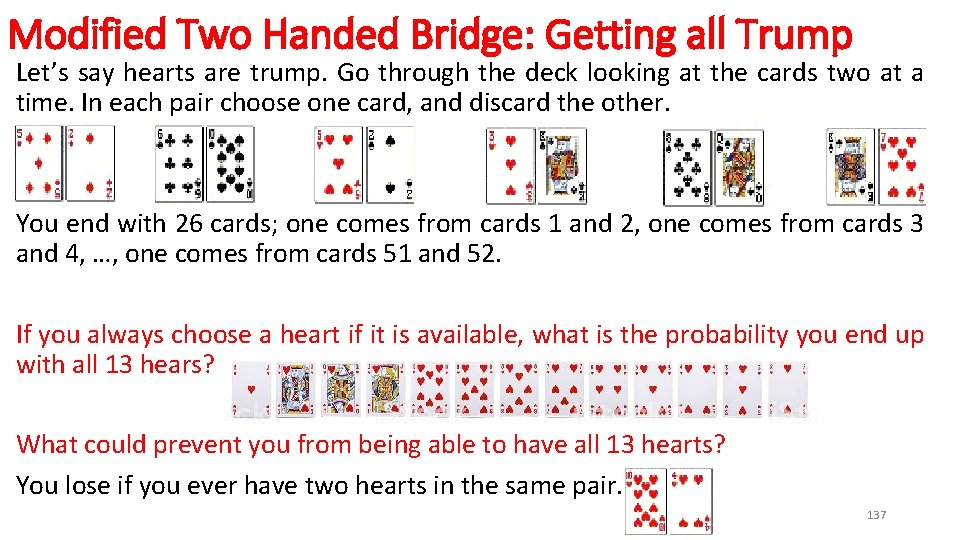
Modified Two Handed Bridge: Getting all Trump Let’s say hearts are trump. Go through the deck looking at the cards two at a time. In each pair choose one card, and discard the other. You end with 26 cards; one comes from cards 1 and 2, one comes from cards 3 and 4, …, one comes from cards 51 and 52. If you always choose a heart if it is available, what is the probability you end up with all 13 hears? What could prevent you from being able to have all 13 hearts? You lose if you ever have two hearts in the same pair. 137
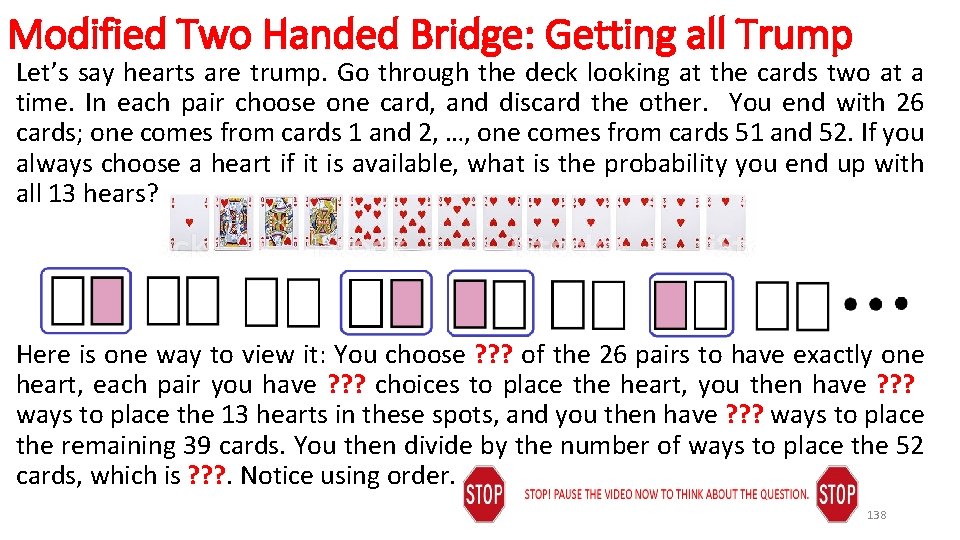
Modified Two Handed Bridge: Getting all Trump Let’s say hearts are trump. Go through the deck looking at the cards two at a time. In each pair choose one card, and discard the other. You end with 26 cards; one comes from cards 1 and 2, …, one comes from cards 51 and 52. If you always choose a heart if it is available, what is the probability you end up with all 13 hears? Here is one way to view it: You choose ? ? ? of the 26 pairs to have exactly one heart, each pair you have ? ? ? choices to place the heart, you then have ? ? ? ways to place the 13 hearts in these spots, and you then have ? ? ? ways to place the remaining 39 cards. You then divide by the number of ways to place the 52 cards, which is ? ? ? . Notice using order. 138
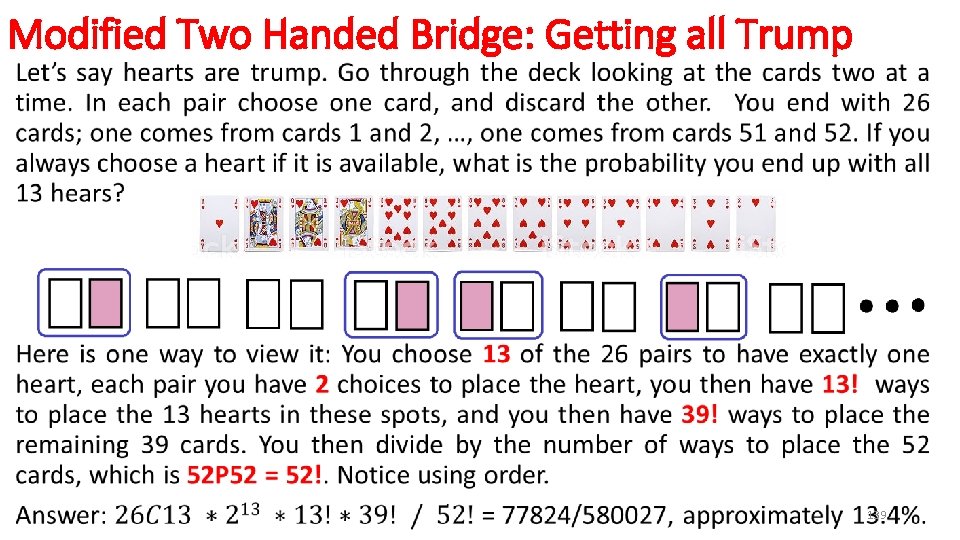
Modified Two Handed Bridge: Getting all Trump • 139
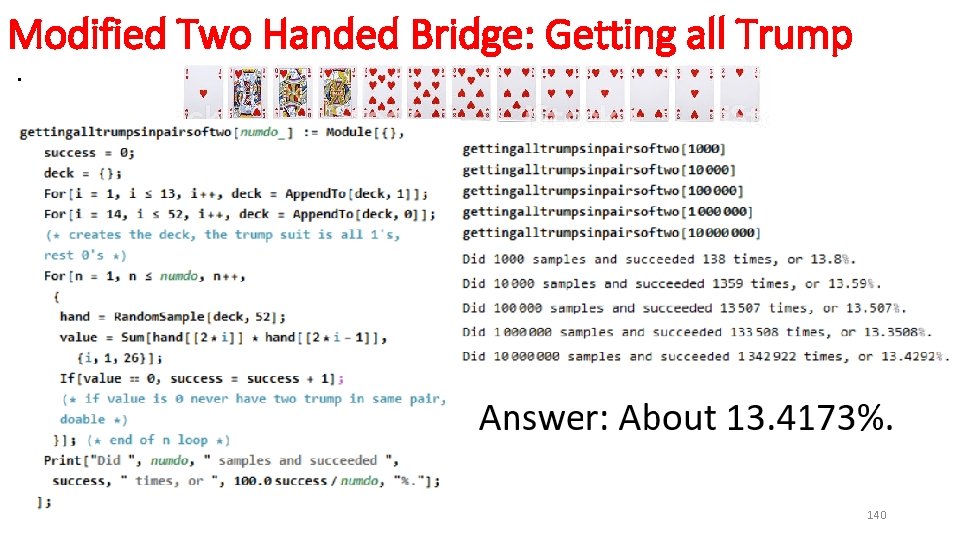
Modified Two Handed Bridge: Getting all Trump. 140
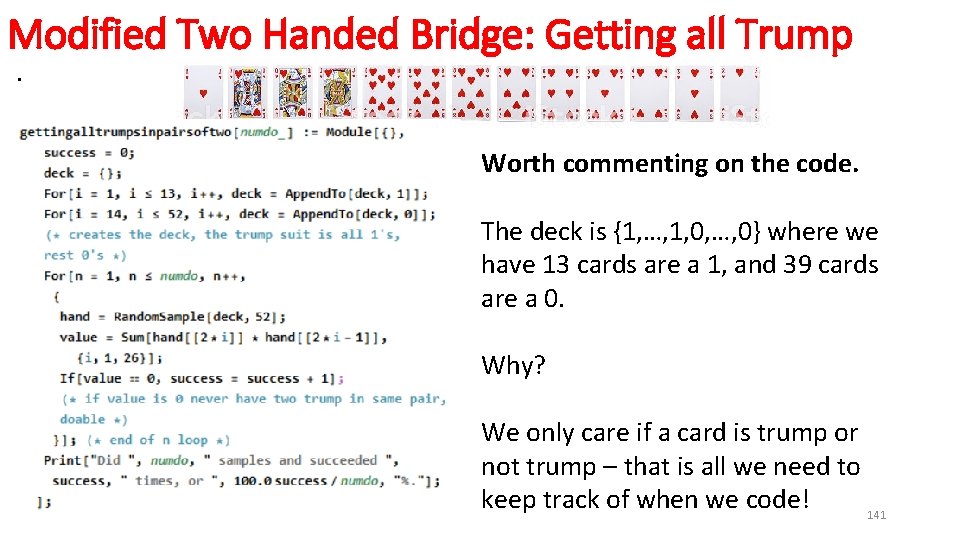
Modified Two Handed Bridge: Getting all Trump. Worth commenting on the code. The deck is {1, …, 1, 0, …, 0} where we have 13 cards are a 1, and 39 cards are a 0. Why? We only care if a card is trump or not trump – that is all we need to keep track of when we code! 141
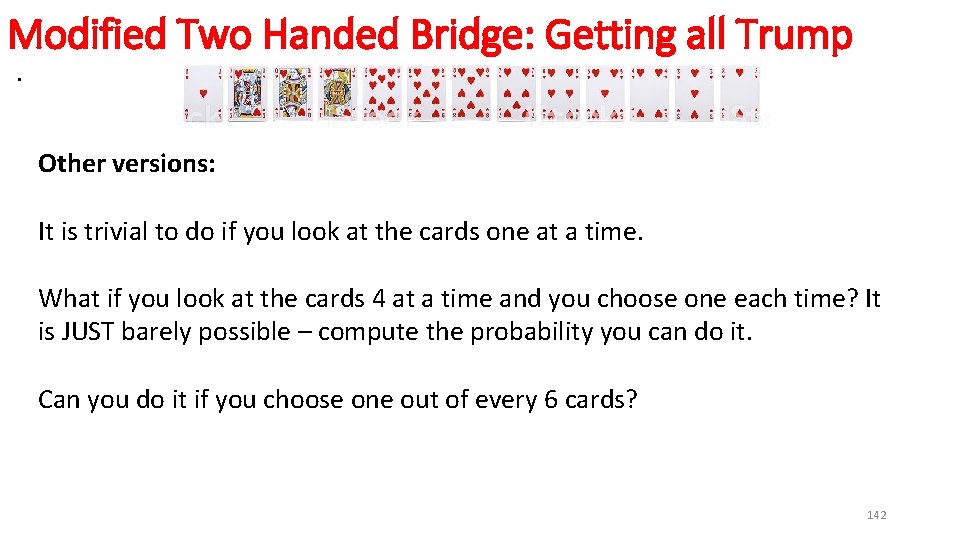
Modified Two Handed Bridge: Getting all Trump. Other versions: It is trivial to do if you look at the cards one at a time. What if you look at the cards 4 at a time and you choose one each time? It is JUST barely possible – compute the probability you can do it. Can you do it if you choose one out of every 6 cards? 142

Poker Problem: 5 Cards, at least two Aces, two Kings Consider a 5 card poker hand. What is the probability have at least two Aces and at least two Kings? How can you do this? What hands would work? What is the difficulty? 143
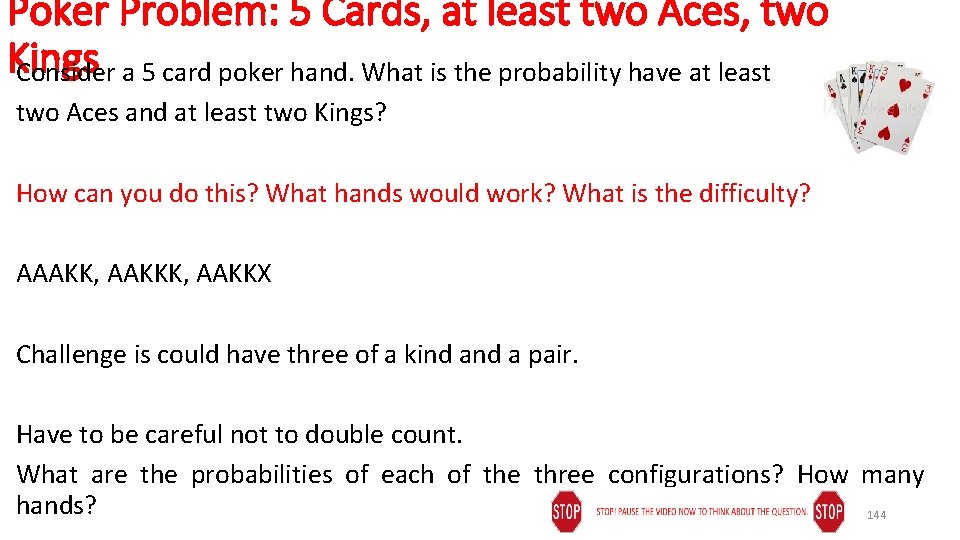
Poker Problem: 5 Cards, at least two Aces, two Kings Consider a 5 card poker hand. What is the probability have at least two Aces and at least two Kings? How can you do this? What hands would work? What is the difficulty? AAAKK, AAKKX Challenge is could have three of a kind a pair. Have to be careful not to double count. What are the probabilities of each of the three configurations? How many hands? 144
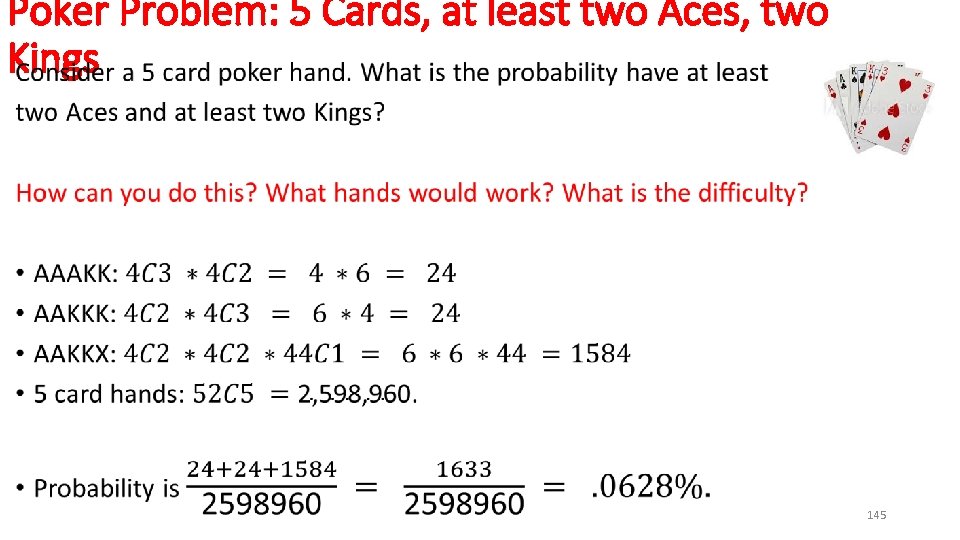
Poker Problem: 5 Cards, at least two Aces, two Kings • 145
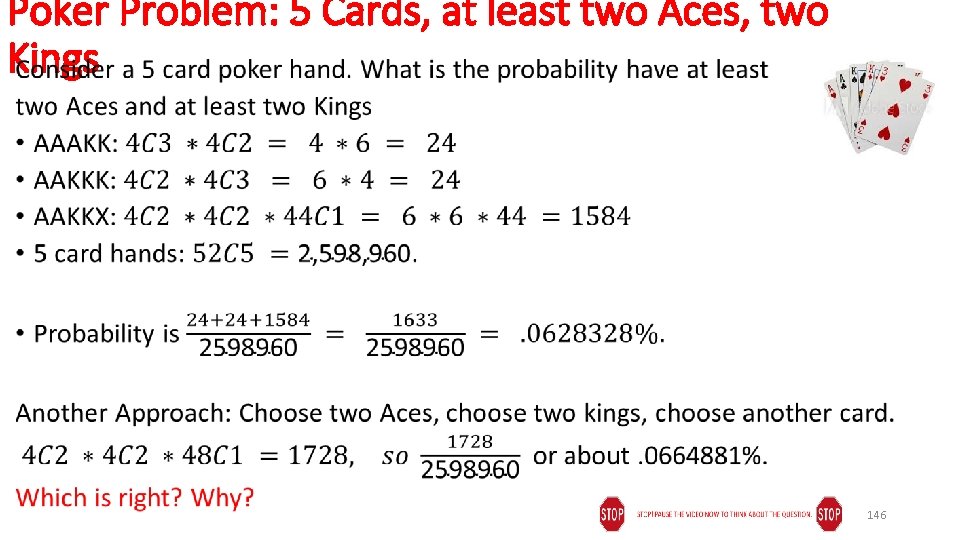
Poker Problem: 5 Cards, at least two Aces, two Kings • 146

Poker Problem: 5 Cards, at least two Aces, two Kings • 147

Poker Problem: 5 Cards, at least two Aces, two Kings • 148

Poker Problem: 5 Cards, at least two Aces, two Kings • 149

Poker Problem: 5 Cards, at least two Aces, two Kings • 150
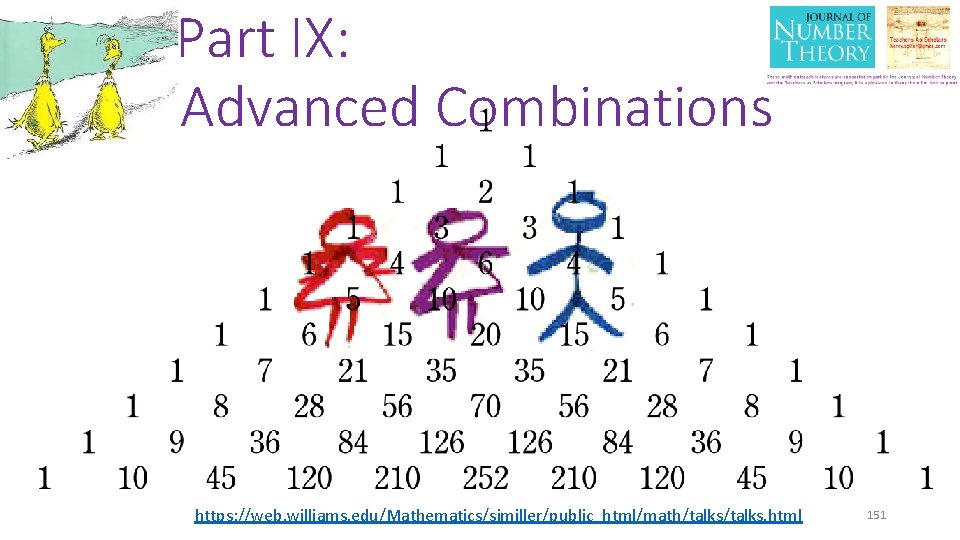
Part IX: Advanced Combinations https: //web. williams. edu/Mathematics/sjmiller/public_html/math/talks. html 151

Expanding (x + n y) (x + y)0 = 1 (x + y)1 = 1 x + 1 y (x + y)2 = 1 x 2 + 2 x y + 1 y 2. (x + y)3 = 1 x 3 + 3 x 2 y + 3 x y 2 + 1 y 3. We can keep going and get more and more rows…. . 152
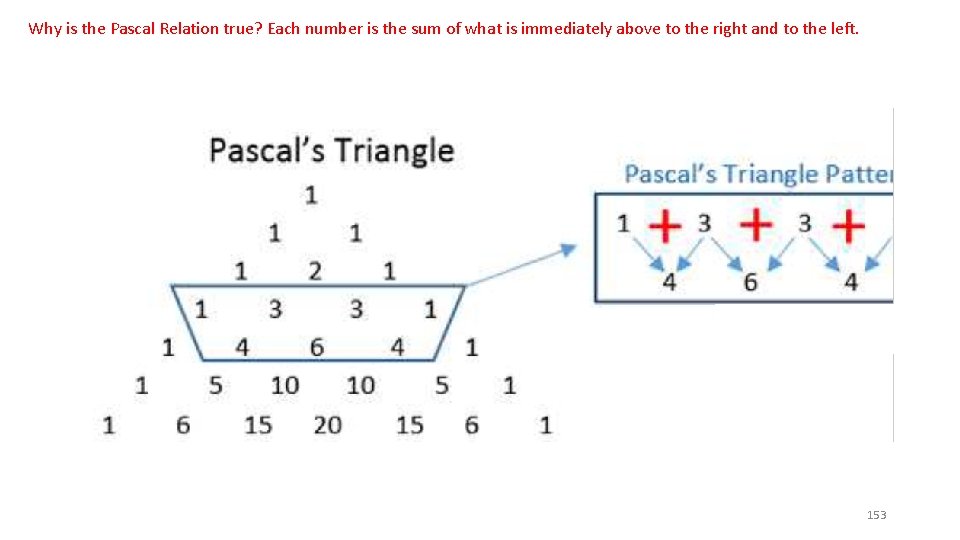
Why is the Pascal Relation true? Each number is the sum of what is immediately above to the right and to the left. 153
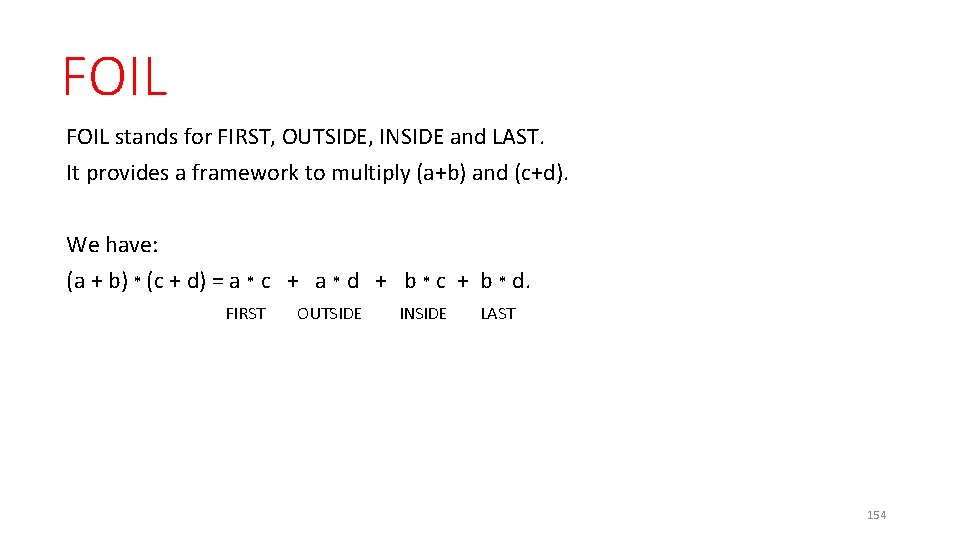
FOIL stands for FIRST, OUTSIDE, INSIDE and LAST. It provides a framework to multiply (a+b) and (c+d). We have: (a + b) * (c + d) = a * c + a * d + b * c + b * d. FIRST OUTSIDE INSIDE LAST 154
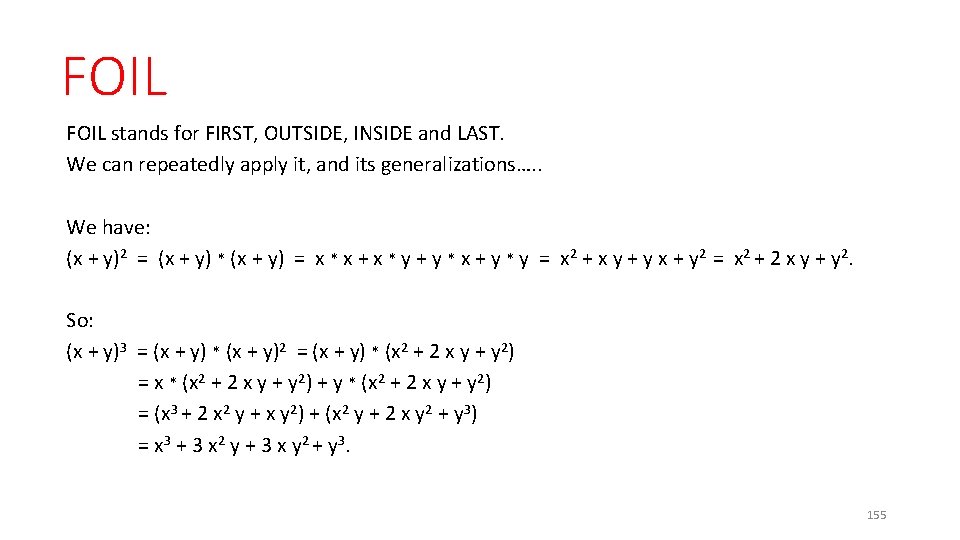
FOIL stands for FIRST, OUTSIDE, INSIDE and LAST. We can repeatedly apply it, and its generalizations…. . We have: (x + y)2 = (x + y) * (x + y) = x * x + x * y + y * x + y * y = x 2 + x y + y x + y 2 = x 2 + 2 x y + y 2. So: (x + y)3 = (x + y) * (x + y)2 = (x + y) * (x 2 + 2 x y + y 2) = x * (x 2 + 2 x y + y 2) + y * (x 2 + 2 x y + y 2) = (x 3 + 2 x 2 y + x y 2) + (x 2 y + 2 x y 2 + y 3) = x 3 + 3 x 2 y + 3 x y 2 + y 3. 155
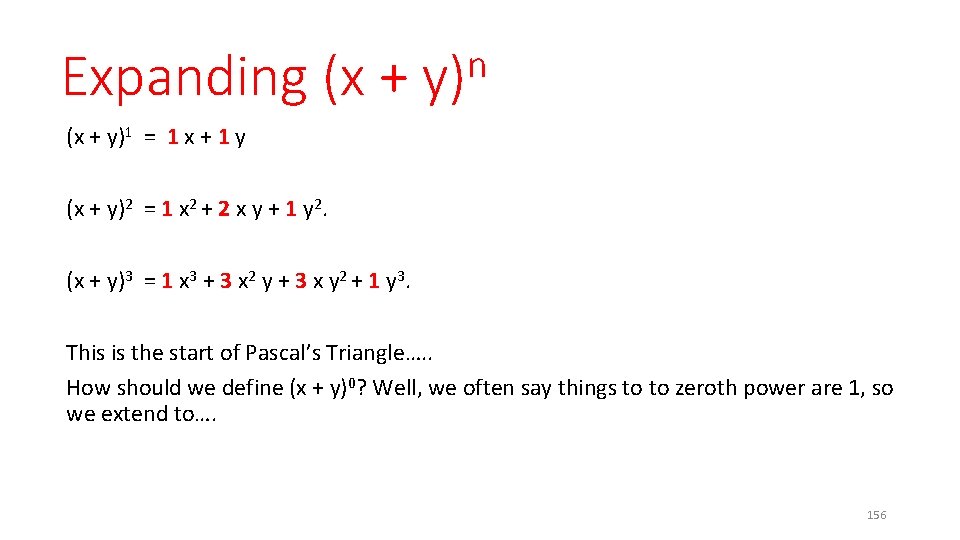
Expanding (x + n y) (x + y)1 = 1 x + 1 y (x + y)2 = 1 x 2 + 2 x y + 1 y 2. (x + y)3 = 1 x 3 + 3 x 2 y + 3 x y 2 + 1 y 3. This is the start of Pascal’s Triangle…. . How should we define (x + y)0? Well, we often say things to to zeroth power are 1, so we extend to…. 156
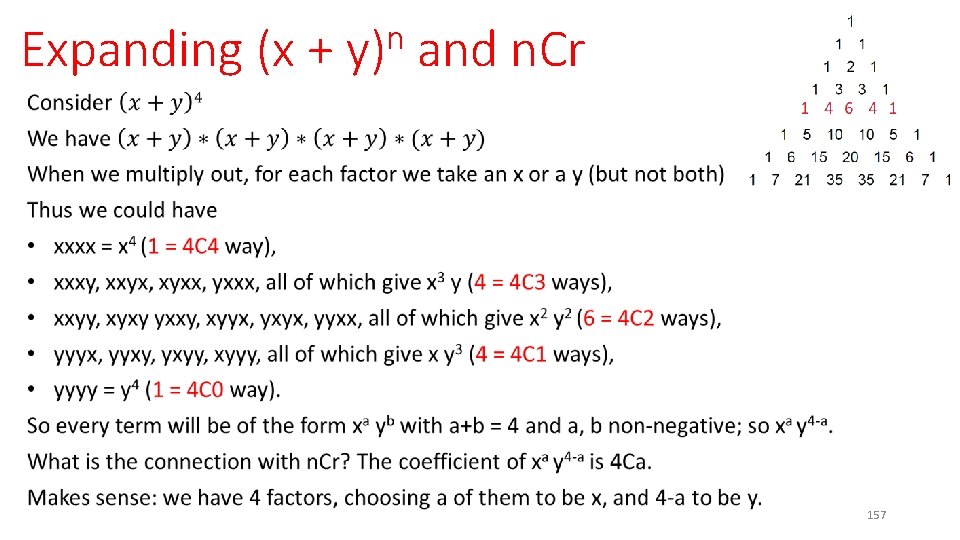
Expanding (x + n y) and n. Cr 157

Pascal’s Triangle The numbers in the nth row of Pascal’s Triangle are the coefficients we obtain in expanding (x+y)n. Equivalently, we have two diagonals of 1, and all other elements are the sum of the elements in the row above immediately to the left and immediately to the right. 158
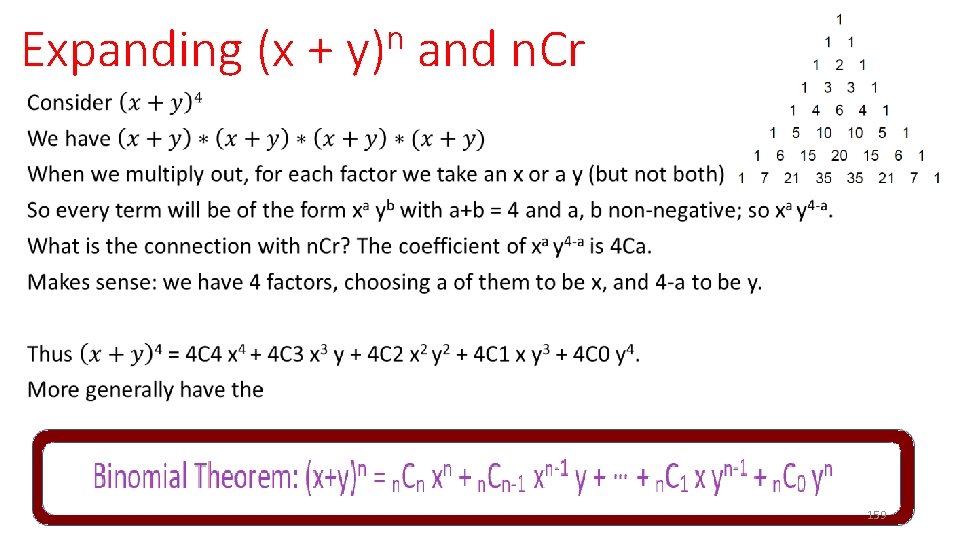
Expanding (x + n y) and n. Cr 159

Sketch of the proof: Assume we know one row, say (x+y)5 = x 5 + 5 x 4 y + 10 x 3 y 2 + 10 x 2 y 3 + 5 x y 4 + y 5. Then (x+y)6 = (x+y)5 = x (x+y)5 + y (x+y)5 = x (x 5 + 5 x 4 y + 10 x 3 y 2 + 10 x 2 y 3 + 5 x y 4 + y 5) + y (x 5 + 5 x 4 y + 10 x 3 y 2 + 10 x 2 y 3 + 5 x y 4 + y 5) = (x 6 + 5 x 5 y + 10 x 4 y 2 + 10 x 3 y 3 + 5 x 2 y 4 + x y 5) + (x 5 y + 5 x 4 y 2 + 10 x 3 y 3 + 10 x 2 y 4 + 5 x y 5 + y 6) = x 6 + 5 x 5 y + 10 x 4 y 2 + 10 x 3 y 3 + 5 x 2 y 4 + x y 5 + x 5 y + 5 x 4 y 2 + 10 x 3 y 3 + 10 x 2 y 4 + 5 x y 5 + y 6 = x 6 + (5+1) x 5 y + (10+5) x 4 y 2 + (10+10) x 3 y 3 + (5+10) x 2 y 4 + (1+5) x y 5 + y 6 = x 6 + 6 x 5 y + 15 x 4 y 2 + 20 x 3 y 3 + 15 x 2 y 4 + 6 x y 5 + y 6 160

Pascal’s Identity: Often write n. Ck as • 161

Pascal’s Triangle 162
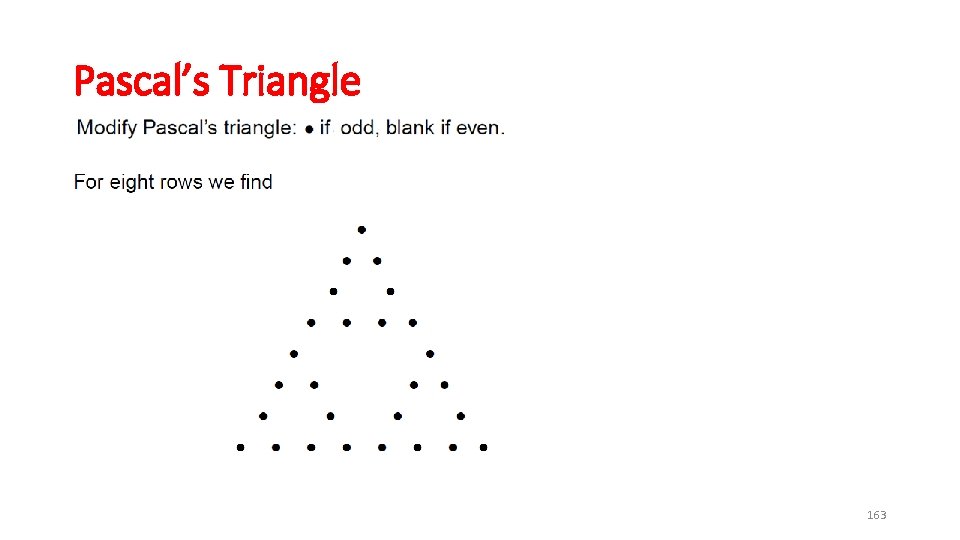
Pascal’s Triangle 163

Pascal’s Triangle https: //www. youtube. com/watch? v=tt 4_4 Yajq. RM (start 1: 35) 164
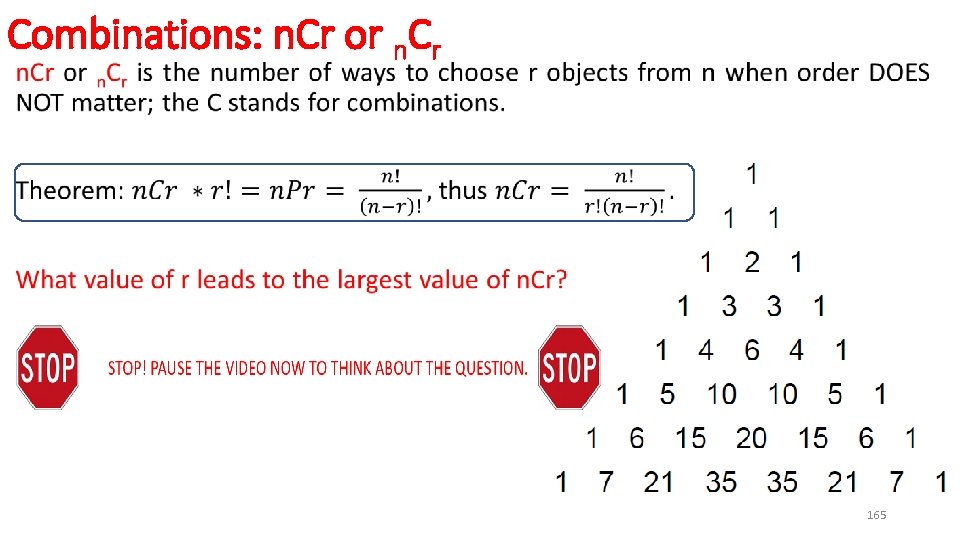
Combinations: n. Cr or n. Cr • 165
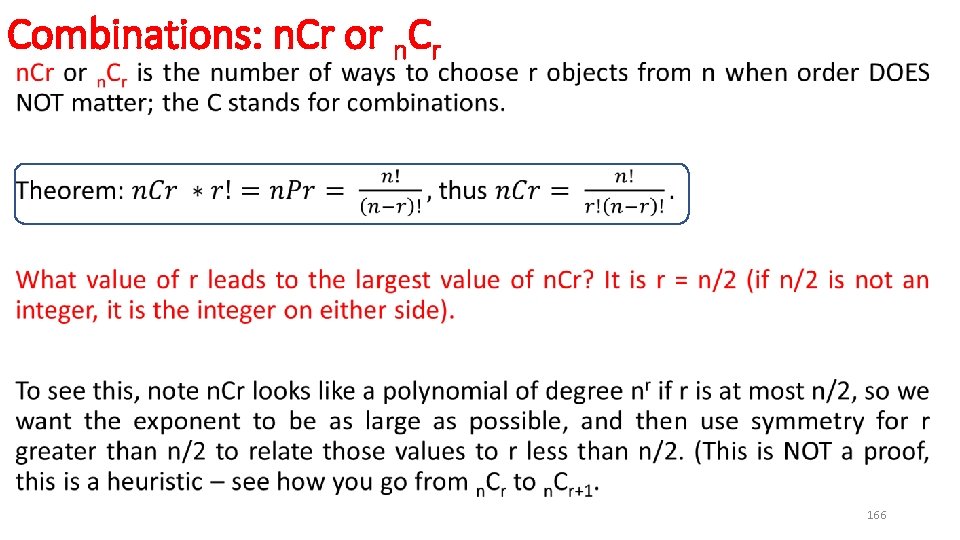
Combinations: n. Cr or n. Cr • 166

Combinations: n. Cr or n. Cr • 167
- Slides: 167